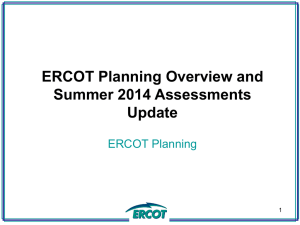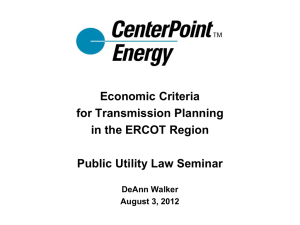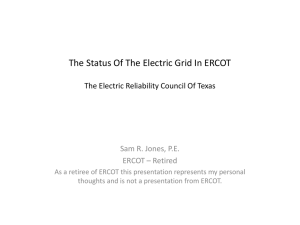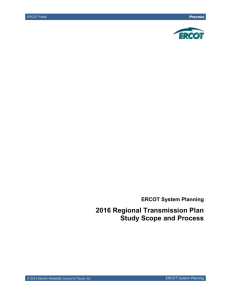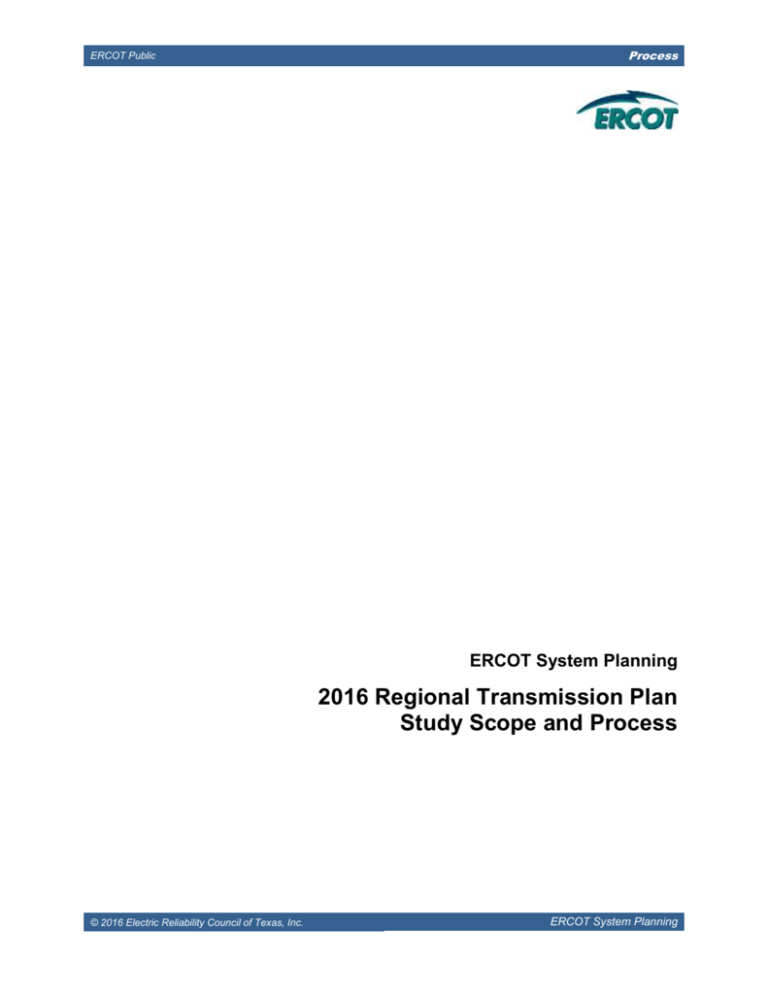
ERCOT Public
Process
ERCOT System Planning
2016 Regional Transmission Plan
Study Scope and Process
© 2016 Electric Reliability Council of Texas, Inc.
ERCOT System Planning
2016 RTP Scope and Study Process
ERCOT Public
Document Revisions
Date
Version
Description
Author(s)
10/8/2014
0
Original Draft
Sun Wook Kang,
Sandeep Borkar
1/14/2015
1
Updated based on internal review and
feedback from Stakeholders
Sun Wook Kang
Sandeep Borkar
© 2016 Electric Reliability Council of Texas, Inc. All rights reserved.
2016 RTP Scope and Study Process
ERCOT Public
Table of Contents
1.
Introduction ................................................................................................................................................ 2
2.
Scope .......................................................................................................................................................... 2
3.
Input Assumptions ...................................................................................................................................... 2
3.1
Transmission Topology ........................................................................................................................... 2
3.1.1 RPG Approved Projects...................................................................................................................... 3
3.1.2 Transmission and Generation Outages ............................................................................................... 3
3.1.3 FACTS Devices .................................................................................................................................. 3
3.1.4 Ratings and Interface Limits ............................................................................................................... 3
3.1.5 Contingency Definitions ..................................................................................................................... 4
3.2
Generation ............................................................................................................................................... 4
3.2.1 Generation Additions and Retirements ............................................................................................... 4
3.2.2 Renewable Generation Dispatch......................................................................................................... 4
3.2.3 Switchable Generation and Exceptions .............................................................................................. 5
3.2.4 DC Ties ............................................................................................................................................... 5
3.2.5 Reserve Requirements ........................................................................................................................ 5
3.2.6 Fuel Price and Other Considerations .................................................................................................. 5
3.3
Demand ................................................................................................................................................... 5
3.4
Managing Imbalance in Cases................................................................................................................. 6
4.
The RTP Process and Method of Study ...................................................................................................... 6
4.1
Case Conditioning ................................................................................................................................... 7
4.2
Reliability Analysis ................................................................................................................................. 7
4.2.1 Cascading outage analysis .................................................................................................................. 8
4.2.2 LTSA Alignment ................................................................................................................................ 8
4.2.3 Sensitivity Analysis ............................................................................................................................ 9
4.2.4 Short Circuit Analysis ........................................................................................................................ 9
4.3
5.
Economic Analysis................................................................................................................................ 10
Deliverables .............................................................................................................................................. 10
© 2016 Electric Reliability Council of Texas, Inc. All rights reserved.
i
2016 RTP Scope and Study Process
ERCOT Public
1. Introduction
The Regional Transmission Plan is the result of a coordinated planning process, performed by
ERCOT Staff with extensive review and input by NERC registered Transmission Planners (TPs),
Transmission Owners (TOs) and other stakeholders. This process addresses reliability and
economic transmission needs for the six-year planning horizon. This process produces a regionwide reliability and economic study of the transmission system in accordance with NERC and
ERCOT planning requirements over a six-year transmission planning horizon. Results of this
process include recommendations for upgrading and improving the existing system and
proposals for new transmission projects that ensure transmission system reliability and relieve
significant anticipated transmission system congestion.
2. Scope
The 2016 RTP shall identify reliability needs and transmission upgrades and additions required
to meet the system needs per criteria set in the ERCOT Planning Guide Sections 3 and 4 and
NERC TPL-001-4 reliability standard.
The 2016 RTP will study the following reliability cases.
Summer peak load cases for years 2018, 2019, 2021, and 2022.
Minimum load case for year 2019.
At a minimum, one sensitivity case each for years 2018 and 2021 summer peak, and 2019
minimum load.
The 2016 RTP will also identify transmission projects that meet the ERCOT economic planning
criteria as stated in the Protocol Section 3.11.2. Economic analysis will be conducted for years
2019 and 2022.
To the extent practicable, projects identified in the 2016 RTP will be based on consensus
between ERCOT Planning and the NERC registered TPs with input from other market
participants.
All stakeholder communication regarding the RTP will be conducted through the monthly
Regional Planning Group (RPG) meetings and mailing lists. Start cases and results of the
analysis will be available for review via ERCOT’s MIS.
3. Input Assumptions
3.1 Transmission Topology
The Steady State Working Group (SSWG) summer peak cases for the years 2018, 2019, 2021,
and 2022 will be used as start cases for reliability analysis. The SSWG minimum load case for
the year 2019 will be used as the off-peak start case.
© 2016 Electric Reliability Council of Texas, Inc. All rights reserved.
2
2016 RTP Scope and Study Process
3.1.1
ERCOT Public
RPG Approved Projects
Per ERCOT Planning Guide Section 3.4.1.1, the starting base cases for the RTP are created by
removing all Tier 1, 2, and 3 projects that have not undergone RPG Project Review from the
most recent SSWG base cases. Projects receiving RPG acceptance concurrently with the RTP
study will be reviewed for any material impact on the analysis. These and any other model
corrections, submitted by the TPs shall be documented and included in the study cases.
3.1.2
Transmission and Generation Outages
All known generation or transmission facilities outages with duration of at least six months are
assumed to be modeled in the SSWG base cases. The list of generator outages will include the
mothballed units as documented in the current Capacity, Demands, and Reserves report. Outages
on seasonally mothballed units will be included in the analysis of the minimum load study case.
3.1.3
FACTS Devices
A data request will be sent out to TOs to confirm the list of FACTS devices which are not
available for steady-state voltage support. Such FACTS devices will be turned off for the RTP
analysis since they are not expected to contribute during steady-state system conditions.
3.1.4
Ratings and Interface Limits
All System Operating Limits (SOLs), including Stability SOLs, shall be respected in accordance
with the latest ERCOT System Operating Limit Methodology. All transmission lines and
transformers (excluding generator step-up transformers) 60-kV and above shall be monitored for
thermal overloads to ensure that they do not exceed their pre-contingency or post-contingency
ratings. Dynamic ratings will be used for both the reliability and economic portions of the
analysis. These ratings will be based on the 90th percentile1 temperature as determined for the
weather zone associated with the transmission element. The table below shows the 90th
percentile temperatures used to derive the dynamic reliability rating.
Table 3.1: 90th percentile temperatures used
in the dynamic reliability ratings calculation
Weather Zone
Coast
East
Far West
North Central
North
South Central
South
West
1
90th-percentile
temperature (°F)
102.4
106.2
110.4
108.4
109.0
105.5
104.0
107.3
Calculated based on the most recent 30-year historical data of annual peak temperatures for each weather zone
© 2016 Electric Reliability Council of Texas, Inc. All rights reserved.
3
2016 RTP Scope and Study Process
ERCOT Public
For voltage analysis, all buses 100-kV and above shall be monitored to ensure that they do not
exceed their pre-contingency and post-contingency limits. It will be noted in the report that
Transmission Planner organizations may have different rating or voltage limit criteria than
specified above. In addition to the voltage limits, 2016 RTP will also monitor the postcontingency voltage deviation for all buses 100-kV and above. This criteria is defined in the
Planning Guide Section 4.1.1.4
Requirement 3.3.1 of TPL-001-4 requires automatic tripping of elements where relay loadability
limits are exceeded. If such ratings are not available a default limit will be used. This default
limit is determined to be the lower of 1) 115% of their emergency ratings and 2)150% of normal
ratings.
Appropriate Panhandle export interface limits, as identified by the latest planning studies, will be
modeled in the economic cases if the total capacity of generation in the economic cases exceeds
the interface limit.
3.1.5
Contingency Definitions
The most current SSWG Contingency Database will be used to create the contingency set for the
RTP analysis. All contingency categories P0-P7, including the extreme events conditions, will
be studied in the 2016 RTP. A detailed list of definitions can be found in Table 1 of NERC TPL001-4.
3.2 Generation
3.2.1
Generation Additions and Retirements
All existing generation plants are retained from the SSWG start cases. Future generation will be
added to the SSWG start cases if all applicable requirements from Planning Guide Section 6.9
are met. The ERCOT Generation Interconnection Status (GIS) database will be used as a
reference list containing the status of future generation. Generation identified as retired or
mothballed based on the most recent information available to ERCOT at the time of case
building and analysis will be modeled as offline for appropriate cases.
3.2.2
Renewable Generation Dispatch
ERCOT will review historical data to determine the dispatch level for hydro units in the reliability
analysis. In the summer peak reliability cases, the wind plants will be dispatched based on the
15th percentile output from vendor supplied profiles sampled for the hours when ERCOT load is
higher than the 95th percentile. The dispatch percentages resulting from this analysis are shown
in Table 3.2. For the Off-Peak reliability case, the historical data of wind resources during the
minimum load conditions will be analyzed to determine maximum wind dispatch output level.
Table 3.2: Wind Dispatch in the 2016 RTP by weather zone
Region
Coast
East
Output
N/A
N/A
North
Central
1%
North South
3%
© 2016 Electric Reliability Council of Texas, Inc. All rights reserved.
10%
South
Central
2%
West
3%
Far
West
3%
4
2016 RTP Scope and Study Process
ERCOT Public
Solar plants in the summer peak reliability cases will be dispatched at 70% of their rated
capacity, based on analysis of vendor supplied solar curves similar to that described for wind
generation. All solar generation in the minimum load reliability case will be modeled offline.
In economic analysis, an 8,760-hour profile will be used for hydro, wind, and solar units. Vendor
supplied 8,760-hour profiles will be used for wind and solar, and historical dispatch will be used
to create hydro 8,760-hour profiles.
3.2.3
Switchable Generation and Exceptions
Per ERCOT Protocol Section 16.5.4, upon receipt of a written notice, Switchable Generation
Resource parameters used in the RTP cases will be updated to appropriately reflect the amount
of switchable generation available to ERCOT for the study cases.
3.2.4
DC Ties
All of the existing DC ties (including those connecting to the Comisión Federal de Electricidad
(CFE)) will be set based on the review of historical DC tie import/export information.
3.2.5
Reserve Requirements
The reliability analysis will be performed based on a reserve requirement of 2800 MW. In the
economic analysis, generation dispatch will include 1,400 MW of responsive reserve
requirements along with regulation requirements.
3.2.6
Fuel Price and Other Considerations
Wind and solar production cost will be $0/MWh in the economic analysis. The natural gas price
will be evaluated at the beginning of the economic analysis. No carbon tax will be considered in
the 2016 RTP. ERCOT will also monitor the output of Dallas-Fort Worth area units that do not
have Selective Catalytic Reduction (SCR) to ensure that they do not exceed their NOx emission
restrictions.
3.3 Demand
The load in the RTP cases is organized and evaluated by weather zones. The RTP cases will be
updated with the higher of either the aggregated weather zone load in the SSWG base cases or
the ERCOT 90th percentile weather zone load forecast. The ERCOT 50th percentile load
forecast, plus self-serve load, will be used for the economic portion of the analysis.
ERCOT will use the “scalable load” information from the SSWG cases to identify nonconforming loads to be used in the RTP cases. Non-conforming loads will be extracted from the
weather zone load and will not vary on an hourly basis in the economic portion of the analysis.
When loads are scaled in a weather zone, all loads, except those identified as non-conforming
within the weather zone, will be scaled by the same percentage and the P/Q ratio at each load
will be kept constant.
Load modeling changes (including shifting loads between substations) and corrections provided
by TPs during the course of the analysis will be documented and included in the study cases.
© 2016 Electric Reliability Council of Texas, Inc. All rights reserved.
5
2016 RTP Scope and Study Process
ERCOT Public
3.4 Managing Imbalance in Cases
If there are not sufficient generation resources to meet the load, loss, and reserve requirements of
the system, the following methods may be used.
The base case may be split into multiple study regions. A study region may be a
combination of multiple weather zones, such that the load inside the study region remains
at the level determined as applicable for the RTP.
The wind and solar generation output level for generators outside the study region may be
increased to a higher value. However, this dispatch may not exceed the following
maximums.
o For a WGR, the maximum Dispatch level is the Seasonal Peak Average Wind
Capacity as a Percent of Installed Capacity as defined in Protocol Section
3.2.6.2.2, Total Capacity Estimate.
o For a PVGR, the maximum Dispatch level is the Solar Unit Capacity as defined in
Protocol Section 3.2.6.2.2, Total Capacity Estimate.
Load outside the study region, starting with the higher-of load levels, may be reduced
until the load and reserve requirements are met.
4. The RTP Process and Method of Study
Figure 3.1 shows the RTP study process.
Figure 3.1: The Regional Transmission Plan Process
© 2016 Electric Reliability Council of Texas, Inc. All rights reserved.
6
2016 RTP Scope and Study Process
ERCOT Public
4.1 Case Conditioning
A data request will be sent out to the TSPs to review and update information to be used in the
2016 RTP cases. This request will include, but will not be limited to, the following information.
Review the list of FACTS devices which will not be used as voltage support devices.
Review the list of Tier 1, 2, and 3 projects in Model-On-Demand (MOD) that have not
completed RPG review.
Review the list of future generation to be added or removed, as well as existing
generation to be retired or mothballed from the 2016 RTP cases.
List of generic equipment with long-lead time requirements in the TSP footprint. TPL001-4 R2.1.5 defines the equipment to be studied in this analysis as having a lead time of
one year or longer.
Following the response on the above data request, the SSWG start cases will be updated using
the input assumptions discussed in this scope document. The summer peak and the minimum
load cases will be prepared in this step. The reliability start cases created after case conditioning
and resulting N-1 overloads will be shared with the stakeholders prior to reliability analysis.
4.2 Reliability Analysis
PowerWorld SCOPF will be run to identify unresolvable constraints in the 2022 conditioned
case. Corrective Action Plans will be studied in collaboration with TPs to find solutions to
constraints under different contingency events per TPL-001-4 and ERCOT Planning Guide
Section 4. Loading on elements 60 kV and above will be monitored for P0, P1, P3, P6-2 (where
the initial condition is the loss of a 345/138 kV transformer), and P7 events. It should be noted
that manual system adjustment is allowed for P3 and P6 planning events. These system
adjustments may include but are not limited to curtailment of DC tie flows, transmission
configuration changes and re-dispatch of Generators if feasible. Loading on BES elements will
be monitored for all other contingency events, including Extreme Events. Voltage violations for
BES buses will be monitored for all contingency events, including Extreme Events. Corrective
Action Plans will be developed per NERC and ERCOT reliability criteria.
Following a contingency where non-consequential load shed is an acceptable Corrective Action
Plan, if the total load shed required to reduce the loading on elements below their 100%
emergency rating is greater than 300 MW, ERCOT will investigate the need for a transmission
improvement project. For an N-1-1 event, if the total load shed required after the first
contingency, but prior to the second contingency, to prevent it from cascading is greater than 100
MW ERCOT will investigate the need for a transmission improvement project. When
investigating the need for a transmission improvement project for either of these two conditions,
ERCOT may decide to not recommend a project based on considering the likelihood and impact
of the event occurrence and the cost and public impact of a transmission improvement project.
Once all reliability projects have been identified (i.e. no unresolvable constraints remain)
projects will be reevaluated to determine if each project is needed. The above analysis will be
repeated for other cases described in the scope section of this document.
© 2016 Electric Reliability Council of Texas, Inc. All rights reserved.
7
2016 RTP Scope and Study Process
4.2.1
ERCOT Public
Cascading outage analysis
All contingency events where non-consequential load shed is allowed as a corrective action plan
will be screened to detect potential cascade events for more detailed analysis. The screening to
detect a cascade event will begin by simulation of events that may result in tripping of system
elements as follows:
Transmission facilities (100 kV and above) overloaded beyond their relay loadability
limits (defined in section 3.1.4)
Generator buses where voltage on the low or high side of the Generator Step Up (GSU)
transformer are less than known or assumed minimum generator under-voltage trip limits
Generator buses where voltage on the low or high side of the Generator Step Up (GSU)
transformer exceed known or assumed maximum generator over-voltage trip limits
Buses with known UVLS protection schemes where voltages go below the under-voltage
triggering level
If an initiating event results in any one of the following conditions, the event will be selected as
potential cascade event for more detailed analysis:
The total load loss as a result of system cascading is greater than 6% of the total initial
system load2
The power flow does not converge - which may be a result of a potential voltage collapse
condition, subject to additional confirmation
ERCOT may simplify the above tripping criteria and process further to more effectively identify
cascading events.
The events identified as potential cascade conditions will be studied further in co-ordination with
associated TPs. In the detailed analysis, an event will be defined as cascading if the total load
loss as a result of system cascading is greater than 6% of the total initial system load. If power
flow does not converge as a result of system cascading, ERCOT will conduct a voltage stability
assessment. If the result of the assessment indicates system wide voltage stability issue, the event
will also be defined as cascading. Appropriate corrective action plans will be developed in
accordance with Table 1 of the NERC Reliability Standard TPL-001-4. Possible corrective
measures, including potential mitigation plans, generator re-dispatch, and controlled load shed,
or a transmission improvement project will be considered.
4.2.2
LTSA Alignment
Large projects (e.g., 345-kV) will be further evaluated using most recent Long-Term System
Assessment (LTSA) cases to ensure project robustness and long-term effectiveness. Project
concepts identified in the LTSA will be reviewed as an aid to identifying project
recommendations that will provide long-term benefits either as part of a long-term plan for the
development of the system or as an alternative to recommending a series of smaller incremental
projects over time. Areas identified in the LTSA as requiring a significant number of system
2
Based on Section 3.7 of the SOL Methodology for Operating and Planning Horizon
© 2016 Electric Reliability Council of Texas, Inc. All rights reserved.
8
2016 RTP Scope and Study Process
ERCOT Public
upgrades will be evaluated on a long-term basis if upgrade needs are identified in the area during
the 2016 RTP analysis.
4.2.3
Sensitivity Analysis
NERC TPL-001-4 R2.1.4 requires transmission planners to study impact of changes to basic
assumptions via Sensitivity Analysis. For the 2016 RTP Summer Peak sensitivity cases, ERCOT
will perform ‘No-Wind’ sensitivity on base cases for years 2 and 5. The South/South Central and
Coast/East study region will be studied by turning all Wind Generation Resources in the
South/South Central weather zones out of service in the corresponding base cases. Similarly, the
North/North Central and West/Far West study region will be studied by turning all Wind
Generation Resources West/Far West/North/North Central zones out of service in the
corresponding base cases. Similar ‘No-wind” sensitivity will be performed on years 3 and 6,
however the analysis will be limited to only P0, P1 and P7 planning events.
For the 2016 RTP Off-Peak sensitivity case, ERCOT will perform ‘High-Wind Low-Load’
sensitivity on base case for year 3. ERCOT will review the historical data of coastal and noncoastal wind resources during the high wind conditions to determine the maximum dispatch level
in all wind generation modeled in the minimum load case. The load level at each weather zone
will also be determined by reviewing the historical data during the high wind conditions.
The sensitivity analysis will be performed with all reliability solutions identified from the base
case analysis to evaluate the effectiveness and robustness of the base case solutions under the
stressed system conditions. For any new constraints found in the sensitivity analysis, ERCOT
will identify potential corrective action plans which will be shared with stakeholders as a
reference to guide analysis of future system conditions.
4.2.4
Short Circuit Analysis
ERCOT will perform a short circuit analysis based on three-phase to ground fault and single-line
to ground (SLG) fault. The study will be conducted using the 2019 and 2021 summer peak
reliability base cases with all projects identified in the 2016 RTP. All generators modeled in each
case will be turned online except those determined in the 2016 RTP Scope (e.g. mothballed units
or units with the notice of Suspension of Operations of a Generator Resource).
Faults will be tested at all BES buses (typically, 100 kV and above) and all point of
interconnection (POI) buses associated with generators. For sequence impedance data required
for the study, ERCOT will use the following assumptions and methodology.
For transmission facilities in the RTP cases, positive sequence impedance will be based
on the impedances in the RTP cases. Negative sequence impedance is identical to
positive sequence impedance. For zero sequence impedance, the database built for
ERCOT System Protection Working Group (SPWG) will be used. If zero sequence
impedance data of a transmission line is not available, ERCOT may use a default value
(typically, three times greater than positive sequence impedance). If zero sequence
impedance of a transformer is not available in the SPWG database, ERCOT may use the
data of similar transformer in the system or contact TSPs to obtain sequence impedances.
© 2016 Electric Reliability Council of Texas, Inc. All rights reserved.
9
2016 RTP Scope and Study Process
ERCOT Public
For generators in the RTP cases, the database of SPWG will be used to obtain sequence
impedance data. If the data of a generator is not available in the SPWG database, ERCOT
may use either Resource Asset Registration Form (RARF) database or data of a similar
generator in the system.
Load level will be consistent with the RTP cases.
ERCOT will use PTI PSS/E software to conduct the short circuit study using the classical flat
start (e.g. FLAT,CL in PSS/E) method for the conditioning of the pre-fault conditions.
The results of short circuit analysis will mainly include the magnitude of short circuit current and
source impedance associated with each fault. Within 30 calendar days from ERCOT email
notification sent to the NERG Registered TOs and GOs, TSPs and GOs complete the review of
study results and provide a list of over-dutied circuit breaker and corrective action plans.
4.3 Economic Analysis
The final summer peak reliability cases for 2019 and 2022 are uploaded into UPLAN as the
starting economic cases. The UPLAN database will be updated using input assumptions relevant
to economic analysis discussed in this document. After completing a UPLAN run, the congestion
in each case will be organized by its rank and shadow price. Economic projects will be studied in
collaboration with the TPs for the highest congested elements. Once all economic projects have
been identified, a project-back-out analysis is performed to determine if each project is still
economically justified when tested in combination with other economic projects. The final set of
economic projects will be tested in the summer peak reliability case to ensure that the reliability
case is still N-1 secure.
5. Deliverables
In the course of the analysis, the following information, at a minimum, will be shared with the
stakeholders via MIS.
Initial conditioned start cases and list of binding constraints.
Intermediate cases and binding constraints, and proposed reliability and economic
projects as they become available.
Steady-State AC base cases at yearly peak including all reliability and economic projects
for each case.
o Summer peak load cases for years 2018, 2019, 2021, and 2022
o Minimum load case for year 2019.
o Each sensitivity case each for years 2018 and 2021 summer peak and 2019
minimum load.
A final congestion table will be posted for each study year in the economic analysis.
© 2016 Electric Reliability Council of Texas, Inc. All rights reserved.
10



